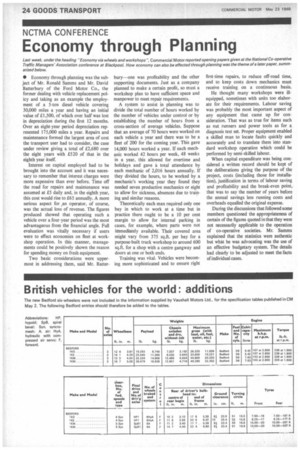NCTMA CONFERENCE
Page 26

If you've noticed an error in this article please click here to report it so we can fix it.
Economy through Planning
Last week, under the heading "Economy via wheels and workshops", Commercial M otor reported opening papers given at the National Co-operative Traffic Managers' Association conference at Blackpool. Now economy can also be effected through planning was the theme of a later paper, summarized below.
• Economy through planning was the subject of Mr. Ronald Samms and Mr. David Batterbury of the Ford Motor Co., the former dealing with vehicle replacement policy and taking as an example the employment of a 5-ton diesel vehicle covering 30,000 miles a year and having an initial value of £1,500, of which over half was lost in depreciation during the first 12 months. Over an eight-year period depreciation represented 175,000 miles a year. Repairs and maintenance formed the largest area of cost the transport user had to consider, the case under review giving a total of £2,680 over the eight years with £520 of that in the eighth year itself.
Interest on capital employed had to be brought into the account and it was necessary to remember that interest charges were more expensive than ever before. Time off the road for repairs and maintenance was assumed at £5 daily and, in the eighth year, this cost would rise to £65 annually. A more serious aspect for ,an operator, of course, was the actual loss of revenue. The figures produced showed that operating such a vehicle over a four-year period was the most advantageous from the financial angle. Full evaluation was vitally necessary if users were to effect economies on fleet at workshop operation. In this manner, managements could be positively shown the reason for spending money on fresh equipment.
Two basic considerations were uppermost in addressing them, said Mr. Batter
bury-one was profitability and the other supporting documents. Just as a company planned to make a certain profit, so must a workshop plan to have sufficient space and manpower to meet repair requirements.
A system to assist in planning was to divide the total number of hours worked by the number of vehicles under control or by establishing the number of hours from a cross-section of average vehicles. Suppose that an average of 70 hours were worked on each vehicle a year and there was to be a fleet of 200 for the coming year. This gave 14,000 hours worked a year. If each mechanic worked 42 hours per week, 48 weeks in a year, this allowed for overtime and holidays and gave a total attendance by each mechanic of 2,016 hours annually. If they divided the hours, to be worked by a mechanic's working year they found they needed seven productive mechanics or eight to allow for sickness, absences due to training and similar reasons.
Theoretically each man required only one bay in which to work at a time but in practice there ought to be a 10 per cent margin to allow for internal parking in cases, for example, where parts were not immediately available. Their covered area might vary from 375 sq.ft. per bay for a purpose-built truck workshop to around 600 sq.ft. for a shop with a centre gangway and doors at one or both ends.
Training was vital. Vehicles were becoming more sophisticated and to ensure right first-time repairs, to reduce off-road time, and to keep costs down mechanics must receive training on a continuous basis.
He thought many workshops were equipped, sometimes with units too elaborate for their requirements. Labour saving was probably the most important aspect of any equipment that came up for consideration. That was as true for items such as nut runners and power tools as for a diagnosis test set. Proper equipment enabled a skilled man to locate faults quickly and accurately and to translate them into standard workshop operation which could be performed by semi-skilled labour.
When capital expenditure was being considered a written record should be kept of the deliberations giving the purpose of the project, costs (including those for installation), justification in terms of labour saving and profitability and the break-even point, that was to say the number of years before the annual savings less running costs and overheads equalled the original expense.
During the discussions that followed some members questioned the appropriateness of certain of the figures quoted in that they were not necessarily applicable to the operation of co-operative societies. Mr. Samms explained that the statistics were authentic but what he was advocating was the use of an effective budgetary system. The details had clearly to be adjusted to meet the facts of individual cases.
































































































































